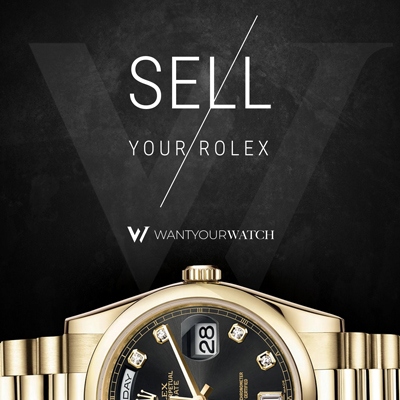Rolex Features
Movement
A watch can have one of two major types of movement: quartz or mechanical. Quartz watches are battery-powered and work by having the battery send electrical power to a small quartz crystal to make it vibrate. The quartz vibrations keep the movement running and drive the stepping motor, which generates hand movement on the dial. Mechanical watches utilize energy from a wound spring (called the mainspring) instead of a battery for power. The winding of the mainspring creates stored/potential energy that is then transferred through a series of gears and more springs, controlling the release of energy to power the functions of the watch. *Watches with quartz movement are generally more accurate than their mechanical counterparts, but they aren’t as popular with watch aficionados as mechanical because they do not have the craftsmanship and engineering that mechanical watches possess. *A key distinguishing feature between quartz and mechanical watches is the second hand movement on the dial. A quartz watch has staccato, tick-tick second hand motion around the dial, while the second hand on a mechanical watch has smooth, sweeping motion.
Mechanical watches are further divided into 2 types: manual and automatic. Manual movement, also called “hand-wound movement,” is the oldest and simplest type of mechanical movement. With a manual-wind watch, the mainspring has to be manually wound to create tension that provides potential/stored energy. The mainspring then gradually unwinds and releases that energy through a network of gears and springs that controls the release of this energy that drives the watch’s hand movements and complications. [THIS PART IS REDUNDANT WITH SOME OF EARLIER PART; TO BE REVISED]
Wearers must manually wind the mainspring by turning the crown on the watch to maintain the mainspring’s tension. Once the mainspring is wound, the watch will keep time and function properly until the next required winding time, which depends on the watch’s specified power reserve capacity. A watch’s power reserve span can range from 24 hours to five days or more (35-45 hours*). Regardless of how long the manual watch can effectively operate until the next required winding interval, it’s usually ideal to wind it at the same time every day.
Mechanical automatic watches, known as the “self-winding” watches, operate the same way that a mechanical manual watch does, except that the mainspring is automatically powered instead of manually powered. In addition to all the normal components like the mainspring, gears, other springs, etc., an automatic watch has an additional component called the rotor. The rotor is a flat, usually semi-circular pendulum weight that is attached to the back of the watch’s movement. The rotor itself is powered by regular, natural movement of the wearer’s wrist, so while the watch is in motion during everyday wearing, the rotor oscillates/spins/swings on a pivot, generating energy that automatically winds the mainspring to produce energy that ultimately powers the watch’s functions. Although the rotor eliminates the need to regular wind the automatic watch like with a manual one, automatic watches still need to be manually wound every so often even if worn regularly(*), but much less often than with a manual watch. *This is because when the watch is not being worn, it continues running off of energy from its power reserve instead of the automatic power from the motion-powered rotor. So when the power reserve is eventually depleted, or if the watch has not been worn for an extended period of time (e.g., 1-2 days*), it must be manually wound (30-40 times*) to generate energy to get it operating again. Automatic watch wearers can use watch winders to keep their watches fully wound during non-wear as a convenient alternative to manual winding.
*All Rolex watches are mechanical automatic (self-winding) watches.
Engine - Calibre
The terms “movement” and “calibre” are often used interchangeably in the watch industry; they essentially refer to the same thing, which is the “engine”/motor of the watch*, but there are some differences in detail. Again, the movement is the internal mechanism (of all the intricate parts – springs, gears, jewels, etc*) that keep the timepiece running with optimal precision. The calibre, more specifically, collectively refers to the positions and sizes of the mechanical parts, particularly the barrel that houses the mainspring and the wheel train.* The calibre denotes the style or size/extent/capability/power?* of the watch’s movement.
Rolex watches come in various types of calibres that possess different properties/features. For instance, the Lady-DateJust 28 is equipped with Rolex Calibre 2236. This mechanism includes a Rolex-patented Syloxi hairspring ( balance spring) made of silicon that is insensitive to magnetic fields. It also provides stability through temperature variations and is 10 times more precise than regular hairsprings in shock exposure*. The Oyster Perpetual 39 features 3132 Calibre movement. It has a Parachrom hairspring and Paraflex shock absorbers that lend the watch high resistance to shock and exposure to extreme conditions.
COSC Certification (Precision)
The precision of a watch is the level of exactness/consistency at which it can measure/record time. For example, one watch can measure time exactly down to individual seconds, while another, more precise watch can track time down to hundredths (a fraction*) of a second. *This level can affect how correctly, or accurately, the watch can keep time. Watch precision is expressed in seconds per day and indicates how many seconds ahead or behind (at most*) the watch’s time may be from the true/correct time. So to continue with the example, that first watch has a precision of +1/-1 second per day that corresponds to a 99.998% accuracy, and the second, more precise watch has a +0.02/-0.02 sec/day precision that gives 99.99998% accuracy. A watch’s precision is usually followed by the phrase “after casing,” which means that the stated precision is the actual “final” precision after the movement is placed inside the case, and the watch is ready to be sold*.
Rolex ensures that every watch is COSC-certified. The Official Swiss Chronometer Testing Institute, known as Controle Officiel Suisse Des Chronometres (COSC), is the institutional body responsible for certifying the precision and accuracy of wristwatches in Switzerland. A watch’s movement (outside the casing**) must demonstrate a -4/+6 sec/day precision level (while being tested under various temperatures and positions) for the watch to be COSC-certified. In addition to meeting and exceeding COSC-standard precision requirements, Rolex has its own rigorous, in-house testing process to verify that its watches possess outstanding chronometric precision. This process tests the time-keeping performance of the cased-up movements of watches, along with the waterproof, self-winding, and power reserve capabilities of the watches. To show that all its watches meet both COSC certification requirements and its own high-standard certification process, Rolex created its exclusive Superlative Chronometer designation. Every Rolex watch is accompanied by a green seal stating that it is Superlative Certified (COSC + Rolex certification after casing). **THIS SUPERLATIVE CERTIFICATION WAS REDEFINED IN 2015; THIS UPDATE ENSURED SINGULAR PERFORMANCE** ON THE WRIST.
**All Rolex watches have a precision of -2/+2 sec/day, after casing, exceeding COSC standards and setting a high performance benchmark for mechanical watches.*
Rolex Complications
Dual Time Zone
Dual time zone watches, by definition, display times for two different time zones, which is convenient for travel. Some watches display one of the times zone in a separate sub-dial that provides a full clock for the zone.
A very popular type of dual time zone watch is a GMT watch. Greenwich Mean Time (GMT), also known as Zulu time or Universal Time Coordinated (UTC), is the reference (“zero”) point on the 24-hour scale of international time zones. It’s the standard time zone against which all other world time zones are referenced. It remains the same all year round, so it’s not affected by Summer Time* or Daylight Savings Time. GMT watches display time in a local zone and also time in at least one other time zone in a 24-hour format. By presenting the additional time zone in 24-hour mode, the watch wearer can determine if the second time reading is AM or PM. GMT watches display the second time zone on a 24-hour scale with an extra dial hand (besides hour/minute/second hands) that travels around the dial once every 24 hours. However, this extra hand points to 24-hour incremental markings on the bezel, not the dial.
World Time Zone
Watches that can tell time in all 24 world time zones are known as World Timers. World Timers display the name of a reference city from each time zone on the bezel or dial. The time in a particular zone is read by looking at the scale of the zone to where the hour and minute hands are pointing.
Digital Date
This feature expresses the date numerically through the watches window/aperture that is commonly at the 3 o’clock position.
Analog Date
The analog date function uses a center hand on the dial to point to a particular date indicated on the outside of the dial (on the bezel?)
Day Date
This feature provides the day of the week along with the (digital) date display. The day of the week is commonly displayed through another window at the noon position, with the date display typically positioned at the 3 o’clock position.
Triple Calendar
A triple calendar complication presents the current month, day and year using three apertures that are typically placed at the noon position of the watch.
Annual Calendar
An annual calendar complication requires the watch date to be set only once per year at the end of February. It’s a complete calendar that shows the day, date and month. It requires little adjustment, as it adjusts the displayed date automatically based on 30- and 31-day months to maintain date accuracy.
Perpetual Calendar
A perpetual complication is much more advanced than an annual calendar and requires much less adjustment. Like an annual calendar, a perpetual calendar also provides the day, date, and month, but unlike the annual, it knows the number of days in each month and the current* year so that it automatically adjusts for leap years.
Chronograph
The chronograph complication gives a watch extended capabilities in measuring time. It is essentially a stopwatch that enables precise measurements of time intervals from fractions of a second to several hours independently of the main time-keeping function of the watch. *Chronographs are provided in sub-dials on the dial of the watch.
Flyback Chronograph
The flyback is an advanced chronograph complication that allows quick restarting of time recording while the chronograph is running. With the flyback, pressing the pusher once* stops the chronograph, resets the time to zero, and restarts it. This speedy capability is useful for split second accuracy.
Rattrapante
French for “split seconds,” rattrapante is also a third major type of chronograph complication that includes an additional seconds hand that superimposed on the chronograph hand. This extra hand allows the measurement of multiple events taking place simultaneously. It enables the measurement of “laps.”
Moonphase
The moon phase complication is a feature that is just as popular for its aesthetic appeal as its utility. A lunar cycle (incl. def*) lasts 29 days, 12 hours, 44 minutes, and 3 seconds. The cycle goes through phases that include new, full, half, and quarter. The moon phase complication displays the current phase of a lunar cycle using a graphic image of a moon presented through an aperture that is commonly above the 6 o’clock position. The complication will only show the illuminated part of the moon that corresponds to the current phase as it would be seen from Earth. Moon phase cycles are often beautifully illustrated on watch dials with vibrant colors and intricate designs.
SIGN UP TO OUR NEWSLETTER
Want Your Watch is an independent watch dealer and is not sponsored by, associated with and/or affiliated with any of the brands listed on this website. Want Your Watch only sells pre-owned watches and provides its own warranties on the watches it sells that are not covered undered a factory warranty. All watch brands are registered trademarks of their respective owners. 2021

